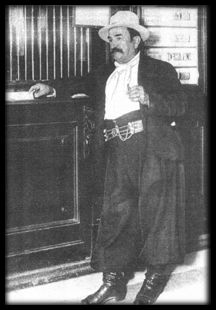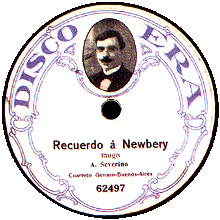By
Carlos D. Nasca, El Gaucho Relámpago

he origin of phonographic industry in our country is not only the product of the effort of the foreign enterprises based in Buenos Aires in the early years of the century. There was, at the same time, a group of pioneering manufacturers of national trademark discs, made through rudimentary technical means and scarce capital amount whose effort made possible the perdurability of innumerable tango pieces by anthological orchestral outfits and, now historical, voices.
 Unnecesary is to point out the documentary value as a testimony contributed by the recorded expressions, then it is a deserved recognition to distinguish those who made possible so important renderings.
Unnecesary is to point out the documentary value as a testimony contributed by the recorded expressions, then it is a deserved recognition to distinguish those who made possible so important renderings.
To the known names of Juan B. Tagini, founder of the labels Sonora and Tocasolo and Alfredo Améndola, of the Atlanta label, we have to add another leading figure, not so known, with a career deserving attention. We are talking of Carlos D. Nasca, founder of the recorded pieces labeled as ERA.
This driver of popular music not only did he devote his efforts to disc, but he also published printed music, composed various of these expressions and was a contributor to the formation and spreading of outfits devoted to the genre.
His activities encompassed functions so different as circus shows producer supplying the animals for the numbers with audience, linking, in that way, his inclinations for the show stage and Nature. He is still recalled by old actors when he was in charge of the horses he led and looked after at the shows where Juan Moreira was a referential representation and the novilladas for the Teatro Avenida when at its stage bullfighting was parodied.
ERA publishing company popularized a label, most times white, sometimes with a pink background, bearing the drawing of a riding gaucho with his dog and lariat, talking to a girl. The scene is drawn under Nasca's indications who wanted to be portrayed, with his daughter in a classic gaucho-like scene.
 The grooved pieces were obtained by a mechanical system recording on the virgin wax matrixes. Large horns were receiving the interpreters´ performance. In spite of the poor fidelity yielded through the procedure, the ERA discs fulfiled the role of spreading and being custody of the interpretations of qualified staffs such as those led by Genaro Espósito, Vicente Loduca, Roberto Firpo, Juan Maglio, Félix Camarano, Peregrino Paulos and Juan Carlos Bazán; or curious solos on street barrell organ; recordings by Francisco Bianco (Pancho Cuevas), Ángel Villoldo and the Rondalla del Gaucho Relámpago, the impresario-producer who, at the beginning of each number, hurriedly shouted the disc trademark name.
The grooved pieces were obtained by a mechanical system recording on the virgin wax matrixes. Large horns were receiving the interpreters´ performance. In spite of the poor fidelity yielded through the procedure, the ERA discs fulfiled the role of spreading and being custody of the interpretations of qualified staffs such as those led by Genaro Espósito, Vicente Loduca, Roberto Firpo, Juan Maglio, Félix Camarano, Peregrino Paulos and Juan Carlos Bazán; or curious solos on street barrell organ; recordings by Francisco Bianco (Pancho Cuevas), Ángel Villoldo and the Rondalla del Gaucho Relámpago, the impresario-producer who, at the beginning of each number, hurriedly shouted the disc trademark name.
The issued repertoire, of selected quality, includes names whose mention excludes comments: Eduardo Arolas, Juan Carlos Bazán, Francisco Canaro, Prudencio Aragón, Eduardo Monelos, Ernesto Zambonini, Ángel Pastore, Muñecas, Antonio Cacace, Vicente Loduca, etc.
Those impressions made in Germany constitute today, documentary pieces of appreciated value, whose origin was produced betweeen the years 1913 and 1915, by lineups which did not have, in general, recordings with the other labels.
Francisco Canaro, in his book Mis bodas de oro con el tango says: «Carlos Nasca, a picturesque Italian-gaucho character, popularly known under the name of El Gaucho Relámpago, a nickname he was given because even though his origin was unmistakably Italic, the man had the hotheaded «berretín» (whim) of believing himself a gaucho, and for that reason he was always in rural costume and was often seen along downtown streets riding a dark chestnut-colored horse, with flashy «chapeado» (with metal sheets) saddle, and halter and reins with silver circlets».
The historian Enrique Puccia in Barracas, su historia y su leyenda remembers him working at the Sola station of the Ferrocarril Sud (Southern railroad): «At those places Carlos Nasca, an Italian deeply fond of folk manners, to the point of being known as El Gaucho Relámpago, also made his figure stand out. With an arrogant appearance, he dressed «a lo estanciero» (rancher style) and was specialized in taming horses which he later rented to the circuses where the early native plays were performed. He was also part of a phonographic record company which bore his nickname, many of these discs are still kept by collectors. Don Carlos died as a consequence of a kick by one of the animals he owned».
Through his daughter's testimony we came to know he was born in Italy in March 1873, son of Juan and Magdalena Brescia; arrived at the country with which he fanatically identified himself, by the turn of the century and settled on 1547 Garay street at the time of the Centennial (1910).
On Octubre 27, 1909 he married María Díaz, a young and beautiful Spaniard born on May 1886 from the marriage of José and Margarita Blanco. The couple had a lot of affinities: his wife, from the circus world, known as La Gaucha María, a curious coincidence which indicates, by the similitude of nicknames, the integration of both foreigners to the new homeland.
Soon afterwards they moved to 56 Juan Carlos Gómez street, a house Nasca lived in until his death happened on May 30, 1936.
In the neighborhood of Parque de los Patricios he placed his performance center. Facing the former quarters of the Infantry regiment 3 (Garay and Pichincha streets) he established a multiple activity shop, because there he composed tangos, programmed the activity of the recording label, and he gathered friends and figures connected to popular music.
He composed numerous works,among them the tangos: “Cajetilla de arrabal”, “Trompito”, “Puro corte”, “Qué dirán”, “Invierno”, “El eléctrico” (same name as Vicente Greco's), “El indiscutible”, “Hagan buches”, “Quién lo diría”, “El clarín”, “Feria franca” and “Los cardales [b]”, among others; the mazurka “Amor de madre [b]” and the waltzes “La oración”, “El ibérico”, “Noches de luna [b]” and “Lluvia de sonrisas”.
To the composer, born abroad but with a creole vocation, indefatigable driver and advocate of the urban expression in its early years, we had to show him that he is not forgotten. This is our testimony.
Published in Hombres de tango y el barrio, fascicle Nº 17 by the Ateneo de Estudios Históricos Parque de los Patricios. April-June 1974.